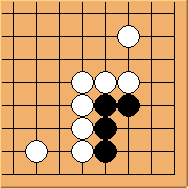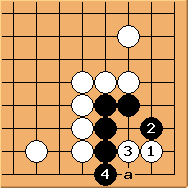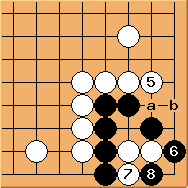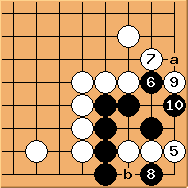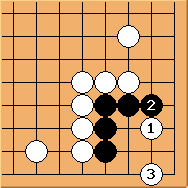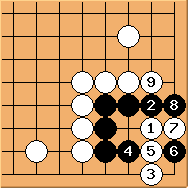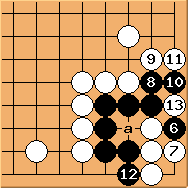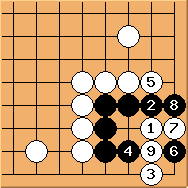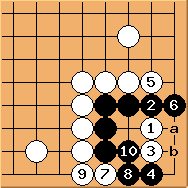All you need to know about Carpenter's Square - 23
Let's study this 'incomplete' Carpenter's Square.
We will use this diagram as a benchmark. We already know this corner should result in a direct ko (Diagram 2.2 and Diagram 3.5). Can white find anything better?
Unlike many other carpenter's square shapes,  here is not a good move. After
here is not a good move. After  /
/  exchage,
exchage,  is good ('a' would be suicidal because it reduces the eyespace). White has two options from here ......
is good ('a' would be suicidal because it reduces the eyespace). White has two options from here ......
If white plays  , black can form a ko easily after
, black can form a ko easily after  . If
. If  plays
plays  instead, black would make 'a'/'b' exchage first before playing
instead, black would make 'a'/'b' exchage first before playing  - which is a seki.
- which is a seki.
If white plays  here instead, black makes
here instead, black makes  /
/  exchage before playing
exchage before playing  (the familiar tesuji to avoid large-eye killing shapes). Note the result here is a direct ko after
(the familiar tesuji to avoid large-eye killing shapes). Note the result here is a direct ko after  - if black forces white to connect at 'a', black can then play 'b' to get a seki shape while continue to fight the ko. So it looks like
- if black forces white to connect at 'a', black can then play 'b' to get a seki shape while continue to fight the ko. So it looks like  in Diagram 23.3 is no better than the benchmark case.
in Diagram 23.3 is no better than the benchmark case.
 is the vital point in this shape.
is the vital point in this shape.  is a related tesuji. The purpose of
is a related tesuji. The purpose of  is to make an eye in the corner to form Eye versus No Eye capturing race. However, one needs be careful to implement this idea correctly.
is to make an eye in the corner to form Eye versus No Eye capturing race. However, one needs be careful to implement this idea correctly.
This is the solution given in Cho Chikun's Life & Death Dictionary. What's presented here is that white can win this capturing race by one liberty. But something appears to be wrong here ......
Normally  is the previous diagram is the tesuji, but
is the previous diagram is the tesuji, but  here is better.
here is better.  can create a ko this way. This is an approach ko - black need to win the ko and play 'a' to make it a directly ko. But any way, this is better than dead.
can create a ko this way. This is an approach ko - black need to win the ko and play 'a' to make it a directly ko. But any way, this is better than dead.
It turns out that  in Diagram 23.7 is not accurate.
in Diagram 23.7 is not accurate.  here instead would be flawless. If
here instead would be flawless. If  plays
plays  first, the result is exactly the same. If
first, the result is exactly the same. If  plays
plays  , the corner is a Pyramid Four dead shape. Black is dead unconditionally.
, the corner is a Pyramid Four dead shape. Black is dead unconditionally.
If white misses the tesuji  in the solution, for example, if white plays
in the solution, for example, if white plays  here instead, black occupies the key point
here instead, black occupies the key point  and a ko fight is inevitable. For example, the sequence here results in an approach ko. I will leave the readers to work out other variations in this diagram and we will revisit this in the next article in this series.
and a ko fight is inevitable. For example, the sequence here results in an approach ko. I will leave the readers to work out other variations in this diagram and we will revisit this in the next article in this series.
To summarise: Diagram 23.6 + 23.9 is the only solution. White needs to play very accurately to avoid ko fights.

